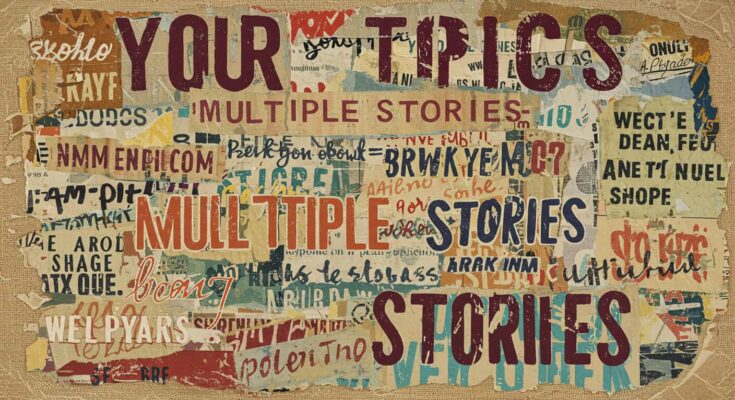In today’s fast-paced digital world, users crave content that not only informs but also resonates deeply. The key to satisfying this demand lies in the art of storytelling—especially multi-angle storytelling. The concept behind the title “Your Topics, Multiple Stories: Building Engagement with Multi-Angle Narratives” is simple yet powerful: take one idea and tell it in diverse, layered ways. By doing this, you expand reach, enhance retention, and improve relevance.
Introduction: Why Multiple Stories Matter
Telling one story is good. But telling multiple stories around your topics is even better. It allows you to:
- Address different segments of your audience
- Expand on a topic without redundancy
- Explore emotional, factual, and experiential dimensions
When a single idea is dissected into various stories, it opens doors to personalization and broader reach. This storytelling method enhances emotional resonance, clarifies complex ideas, and aligns with the way people consume content across platforms today.
The Psychology Behind Multi-Angle Narratives
Different Minds, Different Triggers
Not all users process information the same way. Some respond to statistics and data, others to anecdotes and real-life experiences. By telling your story through multiple angles, you cater to different cognitive styles.
This approach respects audience diversity and leverages it to your advantage. Logical thinkers may favour factual content, while emotional decision-makers prefer storytelling. Combining both strengthens your message and appeal.
Memory and Repetition with Variation
Repetition enhances memory, but variation avoids monotony. When you present the same message through different narratives, it sticks better without feeling redundant.
Our brains are wired to retain information through repeated exposure. By offering content in new ways—such as through visuals, audio, or case studies—you maximize memorability and comprehension.
Strategic Foundations for Multi-Angle Storytelling
Understanding Your Core Message
Before diversifying, ensure your central idea is solid, focused, and aligned with your brand voice.
A well-defined message serves as the foundation for all stories. It ensures consistency and helps you stay on track, no matter how many formats or perspectives you explore.
Defining Clear Audience Segments
Know who you’re speaking to—segment your audience by demographics, behaviours, or interests to tailor each narrative accordingly.
Understanding your audience allows for precise storytelling. A message crafted for busy professionals will differ from one aimed at students, even if both explore the same core idea.
Strategy: How to Implement Multi-Angle Content Creation
1. Start with a Core Topic
Begin with a solid, well-defined core topic. This becomes your anchor. For example, if you’re in health and wellness, a topic might be: “Benefits of Mindfulness Meditation.”
The core topic should be relevant to your audience and scalable in content potential. It must resonate across multiple angles without losing coherence or depth.
2. Brainstorm Possible Angles
Think of angles like:
- Scientific/Research-Based: Clinical studies supporting mindfulness.
- Personal Journey: A story of someone whose life improved through mindfulness.
- Historical/Cultural: How ancient civilizations practised mindfulness.
- How-To Format: A beginner’s guide to mindfulness exercises.
Brainstorming ensures no perspective is overlooked. It provides creative flexibility and allows you to present familiar ideas in novel and compelling ways.
3. Format Stories Differently
- Write blog posts
- Create short videos
- Host podcasts
- Design infographics
Each content format caters to different consumption habits. For example, while one user might prefer reading a guide, another might find a 2-minute video more accessible. Format variety maximizes accessibility.
4. Use Consistent Messaging with Unique Perspectives
Each piece should support the same theme but add unique value. This balance keeps your message cohesive and engaging.
Even when exploring different angles, it’s essential to maintain brand consistency. Messaging should be tailored but not conflicting, delivering complementary insights.
Real-World Examples of “Your Topics, Multiple Stories”
Nike’s Branding Campaigns
Nike doesn’t just say, “Just Do It.” They show it through athletes, social justice stories, community impact, and user-generated content. One topic, multiple stories.
This multi-layered storytelling allows Nike to connect with athletes, activists, and consumers at a personal level. Each campaign angle reflects its brand ethos while targeting specific subgroups.
National Geographic’s Wildlife Series
Their content isn’t just factual. It includes scientific reporting, local folklore, and stunning visuals—all tied to the same topic: wildlife conservation.
By integrating various cultural, scientific, and emotional narratives, they make their stories more engaging and educational for a global audience.
Thought Leadership in Business
Companies like HubSpot or SEMrush often write multiple pieces around a single keyword: guides, case studies, podcasts, FAQs, and infographics. This is content repurposing at its best.
This strategy increases authority, generates SEO value, and fosters trust. Every story format adds to their reputation as thought leaders.
Content Formats that Elevate Story Diversity
Written Content
Blog posts, long-form articles, opinion pieces, and interviews can all reflect unique narrative tones.
Written content remains foundational. It allows detailed exploration of topics and is highly shareable and SEO-friendly.
Visual Content
Infographics, charts, data visualizations, and social carousels offer a visual angle of storytelling.
Visuals simplify complex data and improve comprehension. They are also highly engaging on platforms like Instagram, Pinterest, and LinkedIn.
Audio and Video
Podcasts and video explainers serve users who prefer auditory or visual learning experiences.
These formats humanize the brand and create deeper connections. They’re perfect for storytelling, demonstrations, and interviews.
Interactive Content
Quizzes, polls, and interactive timelines allow users to engage directly with the story.
Interactive elements make users part of the story. This not only improves retention but also increases time-on-page metrics.
SEO Benefits of Multi-Angle Narratives
Enhanced Topical Authority
Covering multiple angles of a topic improves your authority in that niche. Google sees this as thorough, valuable content.
When search engines detect depth and variety, they reward your content with better rankings. You become a go-to source on that topic.
Increased Dwell Time
Visitors stay longer when they have more engaging, varied content on the same topic.
Longer dwell times signal value to search engines. Users are more likely to explore related content, increasing session duration.
Better Internal Linking Opportunities
Each new narrative opens doors for linking to other pages on your site, improving your SEO architecture.
Effective internal linking boosts crawlability and distributes authority across your site, enhancing overall SEO health.
More Keywords, Less Stuffing
With multi-angle content, you can naturally include synonyms and LSI keywords, avoiding keyword stuffing while still boosting visibility.
You diversify your keyword strategy organically, covering more queries without overusing your main phrase.
Integrating “Your Topics, Multiple Stories” into Your Workflow
Create a Content Matrix
Use a spreadsheet to map:
- Core Topic
- Angle
- Format
- Target Audience
- Publication Channel
A matrix helps you track ideas, prevent repetition, and maintain a balanced publishing strategy.
Set a Publishing Cadence
Space out your multi-angle stories over a content calendar to maximize consistency and visibility.
Creating anticipation for future content and maintaining audience engagement are two benefits of publishing in stages.
Monitor and Optimize
Use tools like Google Analytics, SEMrush, and Ahrefs to monitor engagement and adjust your approach.
Analytics offer critical insights into what’s working. Use them to refine angles, formats, and timing.
Collaboration and Cross-Discipline Storytelling
Involve Different Teams
Get input from product, marketing, and customer service teams to surface new storytelling angles.
Each department sees the audience from a different lens. Collaboration enriches content with diverse insights.
Tap Into User-Generated Content
Let your audience co-create content with testimonials, reviews, and social posts.
UGC builds authenticity and trust. It reflects real experiences, which are often more relatable than brand-produced content.
Common Mistakes to Avoid
1. Being Redundant
Avoid rewriting the same story with minor changes. Each piece should offer a genuinely new perspective.
Redundancy frustrates readers and lowers SEO value. Aim for distinct takeaways in each story.
2. Lacking a Unified Message
Different angles are great, but they must orbit the same central idea.
Without a core message, your content feels scattered. Consistency is key for retention and clarity.
3. Ignoring Audience Feedback
Let audience interaction guide your next angle. Use comments, shares, and engagement metrics.
Feedback offers real-time insights. It shows what resonates and what needs refinement.
The Future of Storytelling: AI and Personalization
AI-Driven Story Recommendations
AI can make fresh recommendations based on user activity and popular search terms.
This technology streamlines ideation and improves relevance. It helps scale content without losing personalization.
Dynamic Content Personalization
Create versions of the same story tailored to different personas in real-time.
Adaptive content systems can deliver the right story to the right person at the right moment, increasing conversion and loyalty.
Conclusion: One Topic, Infinite Potential
“Your topics, multiple stories” isn’t just a catchy phrase. It’s a proven strategy to boost engagement, authority, and audience retention. By exploring every angle, you turn ordinary content into a dynamic, evolving ecosystem that resonates with diverse audiences.
Actionable FAQs
What does “Your Topics, Multiple Stories” mean in content creation?
It refers to using a single core idea and developing various narratives around it to engage different audience segments and perspectives.
How can I avoid repeating myself when telling multiple stories on one topic?
Focus on delivering unique value in each piece. Vary your tone, format, and viewpoint while sticking to the same message.
Why is multi-angle storytelling important for SEO?
It improves topical authority, boosts dwell time, enhances internal linking, and allows you to rank for a broader set of keywords.
How many stories should I create per topic?
There’s no fixed number, but aiming for 4–6 unique narratives per topic ensures comprehensive coverage without overdoing it.
Can I use different media for each story angle?
Yes, and you should. Blogs, videos, podcasts, and infographics all offer unique storytelling benefits and improve engagement.



